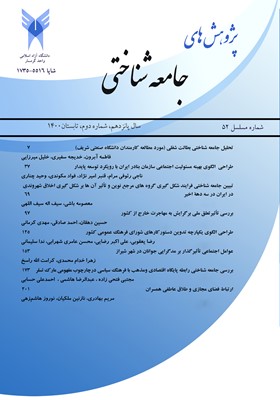ارتباط فضای مجازی و طلاق عاطفی همسران
محورهای موضوعی : در این فصلنامه موضوعات جامعه شناختی در اولویت چاپ هستند و موضوعات نزدیک به جامعه شناسی در اولویتهای بعد قرار می گیرند
مریم بهادری
1
,
نازنین ملکیان
2
![]() ,
نوروز هاشم زهی
3
,
نوروز هاشم زهی
3
1 - کارشناس ارشدگروه علوم ارتباطات اجتماعی، واحد تهران شرق، دانشگاه آزاد اسلامی تهران، ایران.
2 - . عضو هیات علمی گروه علوم ارتباطات اجتماعی، واحد تهران شرق، دانشگاه آزاد اسلامی، تهران، ایران
3 - عضو هیات علمی گروه علوم ارتباطات اجتماعی، واحد تهران شرق، دانشگاه آزاد اسلامی، تهران، ایران .
کلید واژه:
چکیده مقاله :
تغییرات محسوس در نقشها و تکالیف و انتظارات افراد در خانوادهها نشانگر این است که ورود رسانهها انتظارات نقشها را در خانواده دگرگون نموده است. دراین راستا هدف از مطالعه حاضر بررسی ارتباط فضای مجازی با طلاق عاطفی همسران در بین خانواده های منطقه 8 شهر تهران می باشد. روش پژوهش پیمایش و ابزار گردآوری دادهها پرسشنامه تعهد و صمیمیت بروک و برتمن (1995)، پرسشنامه رضایت جنسی هادسون و پرسشنامه محققساخته فضای مجازی است. بر اساس فرمول کوکران از جامعه 377806 نفری زنان و مردان متاهل ساکن در منطقه 8 تهران، 300 نفر با روش نمونهگیری خوشهای چندمرحلهای به عنوان حجم نمونه انتخاب و بررسی شدند. نتایج پژوهش نشان داده است که، 96 درصد از همسران از فضای مجازی استفاده می کنند و میزان طلاق عاطفی در حد متوسط است. همچنین نتایج نشان داده است که بین استفاده از فضای مجازی و طلاق عاطفی همسران (119/0-)، بین فضای مجازی و صمیمیت همسران (327/0-)، و بین فضای مجازی و رضایت جنسی زوجین (178/0-) رابطه منفی و معناداری وجود دارد. در حالی که بین استفاده از فضای مجازی و تعهد همسران رابطه معناداری مشاهده نشده است. همچنین بین نوع عضویت در فضای مجازی و طلاق عاطفی، و نوع سرگرمی و استفاده از فضای مجازی و طلاق عاطفی همسران رابطه معکوس و معناداری وجود دارد.
Maryam Bahadori Master of Social Communication Sciences, East Tehran Branch, Islamic Azad University of Tehran, Iran.Nazanin MalekianFaculty member of Department of Social Communication Sciences, East Tehran Branch, Islamic Azad University, Tehran, Iran (Corresponding Author), nz.malekian@gmail.comNowruz HashemozehiFaculty member of Department of Social Communication Sciences, East Tehran Branch, Islamic Azad University, Tehran, Iran. Significant changes in the plans, tasks, and expectations of individuals in families indicate that the advent of the media has changed the expectations of maps in the family. In this regard, the purpose of this study is to investigate the relationship between cyberspace and emotional divorce of spouses among families in District 8 of Tehran. The research method is survey and the data collection tools are Brooke and Bertman (1995) Commitment and Intimacy Questionnaire, Hudson Sexual Satisfaction Questionnaire and Cyberspace Researcher-Made Questionnaire. According to the Cochran's formula, from a population of 377,806 married men and women living in District 8 of Tehran, 300 people were selected as a sample size by multi-stage cluster sampling. The results show that 96% of spouses use cyberspace and the rate of emotional divorce is moderate. The results also showed that the relationship between cyberspace use and emotional divorce of spouses (-0.119), between cyberspace and intimacy of spouses (-0.327), and between cyberspace and sexual satisfaction of couples (-0.178) There are negatives and meanings. While there is no significant relationship between the use of cyberspace and the commitment of spouses. There is also a significant inverse relationship between the type of cyberspace membership and emotional divorce, and the type of entertainment and the use of cyberspace and spouses' emotional divorce.
_||_


